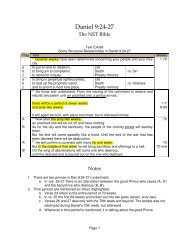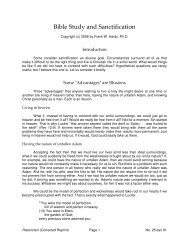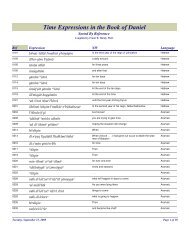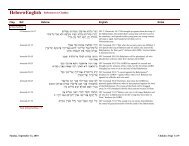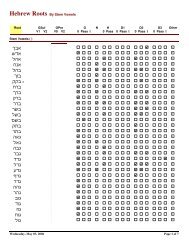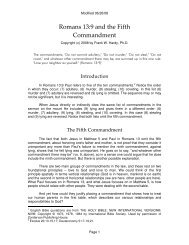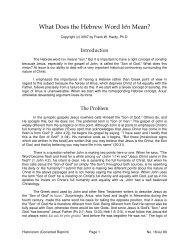A Timeline of the Kings of Israel and Judah - Historicism.org
A Timeline of the Kings of Israel and Judah - Historicism.org
A Timeline of the Kings of Israel and Judah - Historicism.org
Create successful ePaper yourself
Turn your PDF publications into a flip-book with our unique Google optimized e-Paper software.
Hardy<strong>Timeline</strong>NotesNote: All Scripture quotations in this paper, except when noted o<strong>the</strong>rwise, are from <strong>the</strong>Holy Bible, New International Version. Copyright (c) 1973, 1978, 1984 International BibleSociety.1 The Chronology <strong>of</strong> <strong>the</strong> Hebrew <strong>Kings</strong> (Gr<strong>and</strong> Rapids: Zondervan, 1977). In this source<strong>the</strong> author states, "My endeavor has been to set forth <strong>the</strong> results <strong>of</strong> my studies as simply <strong>and</strong>clearly as possible, . . ." (ibid., p. 8). For an earlier <strong>and</strong> more detailed treatment <strong>of</strong> <strong>the</strong> samesubject see idem, The Mysterious Numbers <strong>of</strong> <strong>the</strong> Hebrew <strong>Kings</strong> (Chicago: University <strong>of</strong>Chicago Press, 1951). For a general evaluation <strong>of</strong> Thiele's work see Siegfried H. Horn's paperentitled, "From Bishop Ussher to Edwin R. Thiele," Andrews University Seminary Studies 18(1980): 37-50.2 Chronology, p. 13.3 Ibid.4 <strong>Historicism</strong> No. 8/Oct 86, pp. 2-655 Andrews University Seminary Studies 2 (1964): 40-52.6 Thiele, Chronology, p. 53.7 "Chronology <strong>of</strong> Hezekiah," pp. 46-47.8 Ibid., p. 52.9 7 vols. (Washington, D.C.: Review <strong>and</strong> Herald, 1953-57), 2:151.10 Ibid., 3:151. Notice that <strong>the</strong> wording in <strong>the</strong> quotation from <strong>the</strong> SDA Bible Commentaryis similar to that in <strong>the</strong> quotation from Horn. On <strong>the</strong> one h<strong>and</strong>, ". . . <strong>the</strong> figure given in 2 Ki 17:1,stating that Hoshea became king in Ahaz' 12th year, does not agree with <strong>the</strong> chronologicalscheme proposed here," <strong>and</strong> on <strong>the</strong> o<strong>the</strong>r h<strong>and</strong>, "this last synchronism with <strong>the</strong> reign <strong>of</strong> Ahazdoes not harmonize with <strong>the</strong> rest <strong>of</strong> <strong>the</strong> chronological scheme as it has been worked out from<strong>the</strong> o<strong>the</strong>r data in <strong>the</strong> Bible." Horn may have written both statements.11 New Bible Dictionary, 2nd ed. (Wheaton, IL: Tyndale House, 1982), s.v. "OldTestament Chronology," p. 197. Kitchen <strong>and</strong> Mitchell take Thiele's work as <strong>the</strong>ir starting point<strong>and</strong> for <strong>the</strong> most part follow him closely. In an earlier paper, however, I gave a false impression<strong>of</strong> <strong>the</strong> degree to which <strong>the</strong>y depend on Thiele (see Hardy, "Fall-to-Fall Calendar," p. 59, n. 38).Their chronology represents a careful attempt to refine Thiele's work, but contains someunfortunate overcorrections. They suggest for example that Jerusalem fell in 587 ra<strong>the</strong>r than586, which is inconsistent with 2 Kgs 25:8. This is not a mere error. Kitchen <strong>and</strong> Mitchell statethat from 597 "to <strong>the</strong> final fall <strong>of</strong> Jerusalem, some uncertainty reigns over <strong>the</strong> precise mode <strong>of</strong>reckoning <strong>of</strong> <strong>the</strong> Hebrew civil year <strong>and</strong> <strong>of</strong> <strong>the</strong> various regnal years <strong>of</strong> Zedekiah <strong>and</strong>Nebuchadrezzar in 2 <strong>Kings</strong> <strong>and</strong> Jeremiah" (NBD, p. 193). These issues are addressed in mypaper referenced above. Thiele needs no correction here.Rol<strong>and</strong> Kenneth Harrison, in his Introduction to <strong>the</strong> Old Testament (Gr<strong>and</strong> Rapids:Eerdmans, 1969), pp. 735-36, takes <strong>the</strong> revised chronology <strong>of</strong> Kitchen <strong>and</strong> Mitchell as <strong>the</strong> basisfor his discussion <strong>of</strong> <strong>the</strong> chronology <strong>of</strong> <strong>the</strong> books <strong>of</strong> <strong>Kings</strong> in preference to that <strong>of</strong> Thiele onwhich it is based. Harrison's restatement <strong>of</strong> Kitchen <strong>and</strong> Mitchell is not without innovations <strong>of</strong> itsown. For example, <strong>the</strong> chronology as originally published in The New Bible Dictionary gaveTibni no reign at all, only an unsuccessful coup (885/84). Harrison gives Tibni five years <strong>of</strong>opposition rule during <strong>the</strong> time <strong>of</strong> Omri (885/84-880). Also, by some freudian slip, Kitchen <strong>and</strong>Mitchell argue against Thiele for a coregency between Ahaz <strong>and</strong> Hezekiah (NBD, p. 193) <strong>and</strong><strong>the</strong>n omit that period from <strong>the</strong>ir summary table (ibid., p. 197). Harrison includes <strong>the</strong> missingcoregency (starting 729 B.C.).12 For a solution that is unusual for grammatical ra<strong>the</strong>r than historical reasons seeEdmund A. Parker, "A Note on <strong>the</strong> Chronology <strong>of</strong> 2 <strong>Kings</strong> 17:1," Andrews University SeminaryStudies 6 (1968): 129-33. Parker suggests that ma-lak, normally translated "began to reign" in<strong>Historicism</strong> (Corrected) Page 11 <strong>Timeline</strong>



